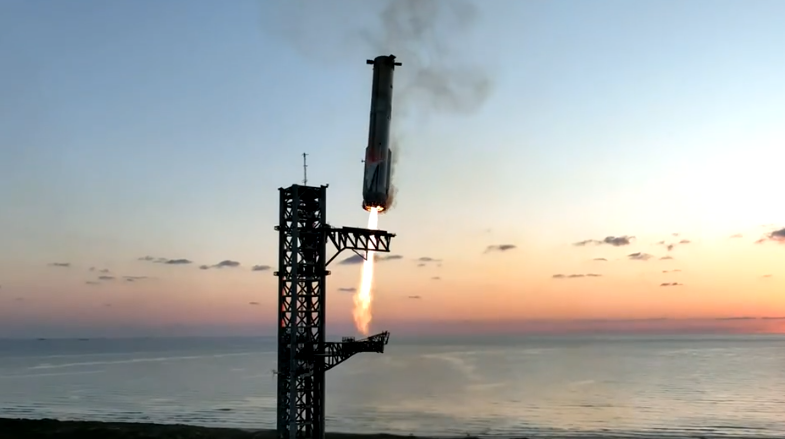
(Photo : spacex.com)
- SpaceX successfully returned the first stage booster of its Starship rocket back to its Texas launch pad using giant mechanical arms.
- The Super Heavy booster re-lit three of its 33 Raptor engines to slow its descent back to SpaceX's launch site.
- The novel catch-landing method marked the latest advance in SpaceX's test-to-failure development campaign for a fully reusable rocket.
- The successful test flight and booster catch is a significant milestone for SpaceX and the broader space industry.
In a groundbreaking feat of engineering, SpaceX, the private American aerospace manufacturer and space transportation company, successfully returned the first stage booster of its Starship rocket back to its Texas launch pad using giant mechanical arms. This marked the first time such a method has been used in the company's ambitious quest to build a reusable moon and Mars vehicle.
The test flight, which took place on a Sunday, saw the rocket's first stage Super Heavy booster lift off from SpaceX's Boca Chica, Texas launch facilities. The booster propelled the Starship second stage rocket towards space before separating at an altitude of roughly 70 km (40 miles) to begin its return to land - the most daring part of the test flight.
The Super Heavy booster re-lit three of its 33 Raptor engines to slow its speedy descent back to SpaceX's launch site, as it targeted the launch pad and tower it had blasted off from. The tower, taller than the Statue of Liberty at over 400 feet, is fitted with two large metal arms at the top.
A Novel Catch-Landing Method
With its engines roaring, the 233 foot (71 meters)-tall Super Heavy booster fell into the launch tower's enclosing arms, hooking itself in place by tiny, protruding bars under the four forward grid fins it had used to steer itself through the air. The tower has caught the rocket!! CEO Elon Musk wrote on X after the catch attempt. SpaceX engineers watching the company's live stream roared in applause.
The novel catch-landing method marked the latest advance in SpaceX's test-to-failure development campaign for a fully reusable rocket designed to loft more cargo into orbit, ferry humans to the moon for NASA and eventually reach Mars - the ultimate destination envisioned by Musk.
Meanwhile, the rocket system's second stage, Starship, cruised at roughly 17,000 miles per hour 89 miles up in space, heading for the Indian Ocean near western Australia to demonstrate about 90 minutes into flight a controlled splashdown.
Starship's Successful Reentry and Landing
As Starship reentered Earth's atmosphere horizontally, onboard cameras showed a smooth, pinkish-purple hue of superhot plasma blanketing the ship's Earth-facing side and its two steering flaps, intense hypersonic friction displayed in a glowing aura. The ship's hot side is coated with 18,000 heat-shielding tiles that were improved since SpaceX's last test in June, when Starship completed its first full test flight to the Indian Ocean but suffered tile damage that made its reentry difficult.
Starship this time appeared more intact upon re-igniting one of its six Raptor engines to position itself upright for the simulated ocean landing. The SpaceX live stream showed the rocket touching down in the nighttime waters far off Australia's coast, then toppling on its side, concluding its test mission.
A separate camera view from a vessel near the touchdown site then showed the ship exploding into a vast fireball, as SpaceX engineers could be heard on the live stream screaming in celebration. It was unclear whether the explosion was a controlled detonation or the result of a fuel leak. Musk said the ship landed precisely on target! Starship, first unveiled by Musk in 2017, has exploded several times in various stages of testing on past flights, but successfully completed a full flight in June for the first time.
This successful test flight and booster catch is a significant milestone for SpaceX and the broader space industry. It marks a major step towards the development of a fully reusable rocket system, which could revolutionize space travel by reducing costs and enabling more frequent launches. This could pave the way for more ambitious missions to the Moon, Mars, and beyond, fulfilling Musk's vision of making life multiplanetary. The journey has not been without its challenges, but the company continues to push the boundaries of what is possible in space exploration, with this latest test flight marking another significant milestone in its ambitious journey.
* This is a contributed article and this content does not necessarily represent the views of btin.co.in









